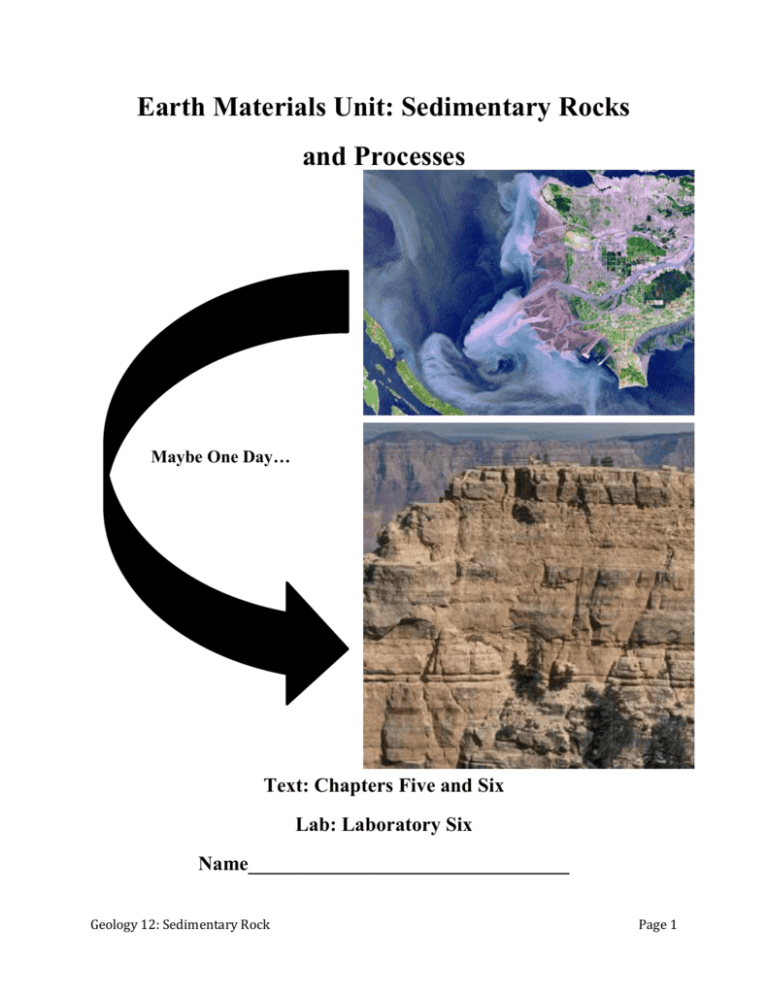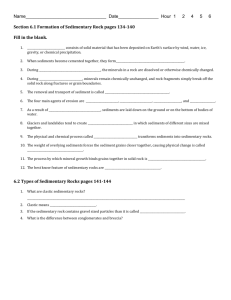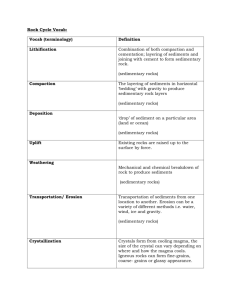File
advertisement

Earth Materials Unit: Sedimentary Rocks and Processes Maybe One Day… Text: Chapters Five and Six Lab: Laboratory Six Name________________________________ Geology 12: Sedimentary Rock Page 1 Sedimentary Rocks and Processes Purpose: To classify sedimentary rocks and features by their physical and chemical properties. -By the end of this unit, students are expected to be able to: 1. Outline the origin and process of sedimentary rock formation. 2. Contrast clastic sediments with chemical (precipitate or biochemical) sediments and the rocks they become. 3. Describe the features of, and identify, the following sedimentary rocks: Conglomerate Limestone Breccia Chert Sandstone Gypsum Siltstone Rock Salt Shale Coal 4. Diagram and describe the following sedimentary features and use them to reconstruct hypothetical sedimentary environments: a) Sedimentary structures: Stratification, crossbedding, ripple marks, mud cracks, graded bedding, varves. b) Particle size, shape and sorting. c) Fossils and organic structures Geology 12: Sedimentary Rock Page 2 Geology 12: Sedimentary Rocks and Processes Part A: What is a Sedimentary Rock? -Sedimentary rock is rock that is composed of sediments. -Sediments are loose grains and chemical residues of rocks and minerals, and of plants and animals. -Sediments are formed from parent materials at a source location. At the source, the parent material is weathered (broken up or dissolved) into sediments or aqueous solutions. -The weathered material is eroded (removed from its source) and transported some distance, and then deposited. -The weathered material is then lithified (hardened into rock by pressure and/or cementation), or precipitates from solution. *95% of the earth’s crust is composed of crystalline rock (igneous or metamorphic). However, sedimentary rock is the most common rock at or near Earth’s surface! Part B: Sedimentary Rock Formation -Using the paragraph above, name the four basic steps in sedimentary rock formation: a) ___________________________________________________________________________________ b)___________________________________________________________________________________ c) ___________________________________________________________________________________ d)___________________________________________________________________________________ *In the following pages, we will explore each of these steps: Step 1: Weathering Processes -Weathering is the chemical or physical breakdown of Earth’s materials. 1. Mechanical (or Physical) Weathering -Mechanical weathering is the _____________________________ _______________________________________________________ _______________________________________________________ -Types of mechanical weathering include: a) Frost Wedging _________________________________________ _______________________________________________________ -What types of sediments and debris features are formed through frost wedging? _______________________________________________________ _____________________________________________________________________________________ _____________________________________________________________________________________ _____________________________________________________________________________________ Geology 12: Sedimentary Rock Page 3 -In what environment would frost wedging be very prominent? ________________________________________________________________ -Where would frost wedging not be found? ________________________________________________________________ ________________________________________________________________ b) Thermal Expansion and Contraction -How can heat cause rocks to be broken down? ________________________________________________________________ ________________________________________________________________ ________________________________________________________________ ________________________________________________________________ ________________________________________________________________ -In what environment would thermal expansion be very prominent? ________________________________________________________________ c) Pressure Release -Describe how an exfoliation dome is created: ________________________________________________________________ ________________________________________________________________ ________________________________________________________________ ________________________________________________________________ -Exfoliation is a big concern in underground mining as it can result in rock bursts. d) Biotic Weathering -How can living organisms cause weathering? ________________________________________________________________ ________________________________________________________________ 2. Chemical Weathering Chemical weathering is the breakdown of rocks and minerals by chemical alteration of the parent material. -How does the product of chemical weathering differ from that of mechanical weathering? ________________________________________________________________ -Water is the most important agent in chemical weathering as it is a universal solvent and its chemical activity is increased by the addition of small amounts of dissolved materials. It plays a leading role in the three major types of chemical weathering: Geology 12: Sedimentary Rock Page 4 a) Dissolution -Some minerals (such as Halite) dissolve easily in pure water, but most minerals are insoluble. However, water containing acid (H+ ions) is a much more efficient weathering agent. -What are three sources for H+ ions? _____________________________________________________________________ _____________________________________________________________________ _____________________________________________________________________ -For example, Calcite (Limestone, Marble) is a mineral dissolved completely by acidic water. No new minerals are created through this reaction! b) Hydrolysis -Reaction of acidic water with silicate minerals (Feldspars, Quartz) that changes the silicate structure of the mineral and results in the production of ions and clay minerals. c) Oxidation -Oxygen combines with iron to form oxides (Hematite and Limonite). -What type of minerals would be most affected? _____________________________________________ _____________________________________________ -Why does oxidation occur more quickly in the presence of water? _____________________________________________________________ ____________________________________________________________ Geology 12: Sedimentary Rock Page 5 *Chemical Weathering Produces: a) Changes to the internal structure of minerals: ____________________________________________________________ ____________________________________________________________ ____________________________________________________________ b) Physical changes to rocks: _____________________________________________________________________________________ _____________________________________________________________________________________ _____________________________________________________________________________________ *Rates of Chemical Weathering are Affected by: a) Rock Characteristics -Mineral Composition: _________________________________ _________________________________ _________________________________ _________________________________ _________________________________ _________________________________ _________________________________ _________________________________ _________________________________ -Physical Characteristics: Why would fractures or particle size affect the rate of weathering? _______________________________________________________ _______________________________________________________ _______________________________________________________ b) Climate: What type of climate would promote greater chemical weathering? _______________________________________________________ _______________________________________________________ _______________________________________________________ Geology 12: Sedimentary Rock Page 6 c) Differential Weathering _______________________________________________________ _______________________________________________________ _______________________________________________________ _______________________________________________________ _______________________________________________________ *Mechanical and chemical weathering occur at the same time and can work in concert: Geology 12: Sedimentary Rock Page 7 Step 2: Erosion and Sedimentary Depositional Environments -Erosion is the movement of weathered materials from its source to depositional environment. -What are some processes of erosion? _______________________________________________ _______________________________________________ _______________________________________________ -Sediments can come in a variety of sizes and shapes and can be classified as: a) Detrital Sediments _________________________ ___________________________________________ ___________________________________________ ___________________________________________ b) Chemical Sediments ________________________ ___________________________________________ ___________________________________________ ___________________________________________ -Would you expect to find angular and very poorly sorted sediments close to or far away from their parent material? _____________________________________________________________________________________ -Sorting and rounding become more prominent the further sediments are transported. -Transported sediments are eventually deposited in three main environments. Take your own notes from text 141 to 144. a) Continental _____________________________________________________________________________________ _____________________________________________________________________________________ _____________________________________________________________________________________ _____________________________________________________________________________________ _____________________________________________________________________________________ _____________________________________________________________________________________ _____________________________________________________________________________________ _____________________________________________________________________________________ _____________________________________________________________________________________ _____________________________________________________________________________________ _____________________________________________________________________________________ _____________________________________________________________________________________ _____________________________________________________________________________________ Geology 12: Sedimentary Rock Page 8 b) Transitional _____________________________________________________________________________________ _____________________________________________________________________________________ _____________________________________________________________________________________ _____________________________________________________________________________________ _____________________________________________________________________________________ _____________________________________________________________________________________ _____________________________________________________________________________________ _____________________________________________________________________________________ _____________________________________________________________________________________ c) Marine _____________________________________________ _____________________________________________ _____________________________________________ _____________________________________________ _____________________________________________ _____________________________________________ _____________________________________________________________________________________ _____________________________________________________________________________________ _____________________________________________________________________________________ Step 3: Lithification -Finally, after being deposited sediments can be transformed into sedimentary rock by lithification, which involves two processes: 1. Compaction __________________________________________ _______________________________________________________ _______________________________________________________ _______________________________________________________ _______________________________________________________ 2. Cementation Precipitation of minerals onto the sediments, eventually filling the pore space and joining sediments together. -What are the most common mineral cements? _____________________________________________________ _____________________________________________________ _____________________________________________________ -Most sedimentary rocks are formed through lithification, but some are products of crystal growth and are called evaporates. We will explore these later in the package. Geology 12: Sedimentary Rock Page 9 -Which of the rocks below was transported the farthest from its source? How do you know? -Which of the rocks below was deposited deeper in an ocean or lake? How do you know? Geology 12: Sedimentary Rock Page 10 Part C: Types of Sedimentary Rocks Detrital Sedimentary Rocks - Detritial sedimentary rocks are separated from Chemical and Biochemical Sedimentary Rocks as they are composed of: _______________________________________________________ -Detrital rocks are also called Siliclastic because their main constituents are: a) ____________________; b) ___________________ -This rock category is divided into different rock types according to grain/sediment size (examine Lab Book Figure 6.3 on page 131). -What can grain size reveal about the depositional environment? ______________________________________________________________________ ______________________________________________________________________ ______________________________________________________________________ ______________________________________________________________________ -Take your own notes on the different types of Detrital Sedimentary rocks: a) Mudstone (Claystone, Shale, Siltstone) Particle Size: ___________________________________________________________ Depositional Environment: ________________________________________________ ______________________________________________________________________ ______________________________________________________________________ ______________________________________________________________________ Strength: __________________________________________________ __________________________________________________________ __________________________________________________________ __________________________________________________________ __________________________________________________________ __________________________________________________________ Breakage: _________________________________________________ __________________________________________________________ __________________________________________________________ Other Characteristics: ________________________________________ __________________________________________________________ __________________________________________________________ Geology 12: Sedimentary Rock Page 11 b) Sandstone (Quartz, Arkose, Wacke) Particle Size: _________________________________________________________________________ Depositional Environment: ______________________________________________________________ Sorting: ______________________________________________________________________________ _____________________________________________________________________________________ Roundness____________________________________________________________________________ _____________________________________________________________________________________ _____________________________________________________________________________________ Composition__________________________________________________________________________ _____________________________________________________________________________________ Types: i) Quartz Sandstone: ______________________________________________ _______________________________________________________________ _______________________________________________________________ ii) Arkose Sandstone: _____________________________________________ _______________________________________________________________ _______________________________________________________________ _______________________________________________________________ _______________________________________________________________ iii) Wacke Sandstone: __________________________________________________________________ _____________________________________________________________________________________ _____________________________________________________________________________________ *The Folk Classification System for Sedimentary Rocks takes the ratio of mud to sand very seriously… Geology 12: Sedimentary Rock Page 12 c) Conglomerate and Breccia Particle Size:__________________________________________________________________________ -Compare and contrast Conglomerate and Breccia depositional environments as revealed by their constituent particles: _____________________________________________________________________________________ _____________________________________________________________________________________ _____________________________________________________________________________________ _____________________________________________________________________________________ Chemical Sedimentary Rocks -Are the product of materials carried in solution when it precipitates to form chemical sediments. -Precipitation occurs as a product of evaporation (crystalline texture) and the chemical activity of organisms like corals (clastic texture). a) Limestone Composition: ____________________________________________________ _______________________________________________________________ _______________________________________________________________ Formation Process: _______________________________________________ Types: i) Organic Limestone: _____________________________________________ _______________________________________________________________ _______________________________________________________________ _______________________________________________________________ ii) Inorganic Limestone: ___________________________________________ _______________________________________________________________ _______________________________________________________________ _______________________________________________________________ Geology 12: Sedimentary Rock Page 13 b) Chert (Flint, Jasper, Agate) Composition: _________________________________________________________________________ Formation Process: _____________________________________________________________________ _____________________________________________________________________________________ _____________________________________________________________________________________ d) Evaporites -Evaporation results in the precipitation of minerals (halite, gypsum) out of solution. Coal -Take your own notes on coal formation from text pages 155 to 166. Geology 12: Sedimentary Rock Page 14 Part D: Reading the Rock Record -The rocks making up Earth’s crust form the only record of prehistory. -Sedimentary rocks are very valuable as they contain evidence of the environment at the type of deposition as their properties result from the physical, chemical and biological processes that existed. -Additionally, the structures that sedimentary rocks form and the fossils they contain can provide further information. Sedimentary Structures A sedimentary structure is any feature in sedimentary rock formed at or shorty after deposition. a) Strata or Beds: ____________________________ ___________________________________________ ___________________________________________ ___________________________________________ ___________________________________________ ___________________________________________ ___________________________________________ b) Bedding Planes: ___________________________ ___________________________________________ ___________________________________________ ___________________________________________ ___________________________________________ c) Cross-Bedding: ________________________________ _______________________________________________ _______________________________________________ _______________________________________________ _______________________________________________ Animation 1, Animation 2 -What direction was the current/wind moving in the various strata? Geology 12: Sedimentary Rock Page 15 d) Graded Bedding: ______________________________ _______________________________________________ _______________________________________________ _______________________________________________ -What type of environment does graded bedding form in? _______________________________________________ _______________________________________________ _______________________________________________ _______________________________________________ -Commonly associated with turbidity currents (an underwater flow of sediments and water with a greater density than sediment free water) or storms. e) Ripple Marks: _____________________ ___________________________________ ___________________________________ ___________________________________ ___________________________________ ___________________________________ -What are the differences between Current Ripple Marks and Oscillation (Wave) Ripple Marks? ___________________________________ ___________________________________ ___________________________________ ___________________________________ ___________________________________ ___________________________________ ___________________________________ ___________________________________ Geology 12: Sedimentary Rock Page 16 -In what direction was the current flowing in the image below? -What type of sedimentary rock is most likely to show ripple marks? _____________________________ f) Mud Cracks: ________________________________________________________________________ Mudstone from the Cambrian period g) Varves: Annual layers of rocks deposited by galcier melt. Geology 12: Sedimentary Rock Page 17









